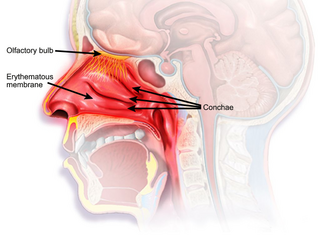
Pseudoephedrine (PSE) is a sympathomimetic drug of the phenethylamine and amphetamine chemical classes. It may be used as a nasal/sinus decongestant, as a stimulant, or as a wakefulness-promoting agent in higher doses.
H1 antagonists, also called H1 blockers, are a class of medications that block the action of histamine at the H1 receptor, helping to relieve allergic reactions. Agents where the main therapeutic effect is mediated by negative modulation of histamine receptors are termed antihistamines; other agents may have antihistaminergic action but are not true antihistamines.

Allergic rhinitis, of which the seasonal type is called hay fever, is a type of inflammation in the nose that occurs when the immune system overreacts to allergens in the air. Signs and symptoms include a runny or stuffy nose, sneezing, red, itchy, and watery eyes, and swelling around the eyes. The fluid from the nose is usually clear. Symptom onset is often within minutes following allergen exposure, and can affect sleep and the ability to work or study. Some people may develop symptoms only during specific times of the year, often as a result of pollen exposure. Many people with allergic rhinitis also have asthma, allergic conjunctivitis, or atopic dermatitis.

Loratadine, sold under the brand name Claritin among others, is a medication used to treat allergies. This includes allergic rhinitis and hives. It is also available in drug combinations such as loratadine/pseudoephedrine, in which it is combined with pseudoephedrine, a nasal decongestant. It is taken orally.

Tranylcypromine, sold under the brand name Parnate among others, is a monoamine oxidase inhibitor (MAOI). More specifically, tranylcypromine acts as nonselective and irreversible inhibitor of the enzyme monoamine oxidase (MAO). It is used as an antidepressant and anxiolytic agent in the clinical treatment of mood and anxiety disorders, respectively.
A decongestant, or nasal decongestant, is a type of pharmaceutical drug that is used to relieve nasal congestion in the upper respiratory tract. The active ingredient in most decongestants is either pseudoephedrine or phenylephrine. Intranasal corticosteroids can also be used as decongestants and antihistamines can be used to alleviate runny nose, nasal itch, and sneezing.

Desloratadine. sold under the brand name Clarinex among others, is a tricyclic H1 inverse agonist that is used to treat allergies. It is an active metabolite of loratadine.

Cetirizine is a second-generation antihistamine used to treat allergic rhinitis, dermatitis, and urticaria (hives). It is taken by mouth. Effects generally begin within thirty minutes and last for about a day. The degree of benefit is similar to other antihistamines such as diphenhydramine, which is a first-generation antihistamine.

Fexofenadine, sold under the brand name Allegra among others, is an antihistamine pharmaceutical drug used in the treatment of allergy symptoms, such as hay fever and urticaria.

Phenylephrine is a medication used as a decongestant for uncomplicated nasal congestion, used to dilate the pupil, used to increase blood pressure, and used to relieve hemorrhoids. It can be taken by mouth, as a nasal spray, given by injection into a vein or muscle, or applied to the skin.

Levocetirizine, sold under the brand name Xyzal, among others, is a second-generation antihistamine used for the treatment of allergic rhinitis and long-term hives of unclear cause. It is less sedating than older antihistamines. It is taken by mouth.

Naphazoline is a medicine used as a decongestant, and a vasoconstrictor added to eye drops to relieve red eye. It has a rapid action in reducing swelling when applied to mucous membranes. It is a sympathomimetic agent with marked alpha adrenergic activity that acts on alpha-receptors in the arterioles of the conjunctiva to produce constriction, resulting in decreased congestion.

Rhinitis medicamentosa is a condition of rebound nasal congestion suspected to be brought on by extended use of topical decongestants and certain oral medications that constrict blood vessels in the lining of the nose, although evidence has been contradictory.

Dexbrompheniramine is an antihistamine with anticholinergic properties used to treat allergic conditions such as hay fever or urticaria. It is the pharmacologically active dextrorotatory isomer of brompheniramine. It was formerly marketed in combination with pseudoephedrine under the name Drixoral in the US and Canada. It is an alkylamine antihistamine.

Acrivastine is a medication used for the treatment of allergies and hay fever. It is a second-generation H1-receptor antagonist antihistamine and works by blocking histamine H1 receptors.

Azatadine (Optimine) is a first-generation antihistamine and anticholinergic drug that was synthesized in 1963 by Schering-Plough, a former American pharmaceutical company.

Ebastine is a H1 antihistamine with low potential for causing drowsiness.
Fexofenadine/pseudoephedrine, sold under the brand name Allegra-D among others, is a fixed-dose combination medication used for the treatment of nasal congestion and other symptoms of allergies and the common cold. It contains fexofenadine, as the hydrochloride, an antihistamine; and pseudoephedrine, as the hydrochloride, a nasal decongestant.
Cetirizine/pseudoephedrine (Zyrtec-D) is an antihistamine and decongestant formulation. It is a fixed-dose combination drug containing 5 mg cetirizine hydrochloride and 120 mg pseudoephedrine hydrochloride for symptoms related to seasonal allergic rhinitis. Cetirizine/pseudoephedrine gained approval from the U.S. Food and Drug Administration in 2001 as a prescription drug and became over-the-counter (OTC) in 2007.
Anti-allergic agents are medications used to treat allergic reactions. Anti-allergic agents have existed since 3000 B.C in countries such as China and Egypt. It was not until 1933 when antihistamines, the first type of anti-allergic agents, were developed. Common allergic diseases include allergic rhinitis, allergic asthma and atopic dermatitis with varying symptoms, including runny nose, watery eyes, itchiness, coughing, and shortness of breath. More than one-third of the world's population is currently being affected by one or more allergic conditions.














